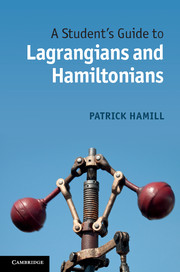6 - Hamilton–Jacobi theory
Published online by Cambridge University Press: 05 June 2014
Summary
In the previous chapter it was mentioned that there is no general technique for solving the n coupled second-order Lagrange equations of motion, but that Jacobi had derived a general method for solving the 2n coupled canonical equations of motion, allowing one to determine all the position and momentum variables in terms of their initial values and the time.
There are two slightly different ways to solve Hamilton's canonical equations. One is more general, whereas the other is a bit simpler, but is only valid for systems in which energy is conserved. We will go through the procedure for the more general method, then solve the harmonic oscillator problem by using the second method.
Both methods involve solving a partial differential equation for the quantity S that is called “Hamilton's principal function.” The problem of solving the entire system of equations of motion is reduced to solving a single partial differential equation for the function S. This partial differential equation is called the “Hamilton–Jacobi equation.” Reducing the dynamical problem to solving just one equation is quite satisfying from a theoretical point of view, but it is not of much help from a practical point of view because the partial differential equation for S is often very difficult to solve. Problems that can be solved by obtaining the solution for S can usually be solved more easily by other means.
- Type
- Chapter
- Information
- A Student's Guide to Lagrangians and Hamiltonians , pp. 134 - 143Publisher: Cambridge University PressPrint publication year: 2013

